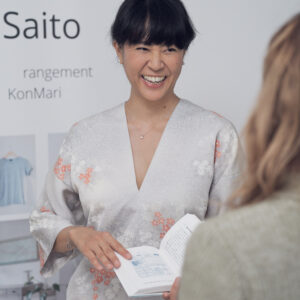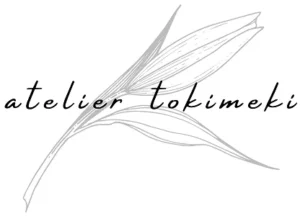I am not a "home organizer"

During an event at UNIQLO Annecy, someone asked me if I was a "home organizer". I admit that at that moment, I stuttered out "Yes, well no, not really, kind of...I'm a tidying consultant, it's different from a home organizer".
I was pleasantly surprised that my interlocutor knew the term “home organizer” and was interested in it. This is not always the case: I often come across people who, surprised, discover that there are professionals offering advice on home organization. Their reaction is sometimes tinged with skepticism, as if the idea of paying to tidy one’s house was a luxury or a whim.
But on my way back, my brain kept mulling over this question. I had so much more to say! I prefer to define my work as a process of inner and outer transformation, well beyond a simple home organization service. Japanese tidying also touches on the spiritual side It’s about making space, not just in our cupboards, but also in our minds and in our schedules. This decluttering process allows us to get rid of what no longer serves us and make room for what truly brings us joy — that famous tokimeki.
So here is a more complete answer, the one I would have liked to give to the question: “Are you a home organizer?”
No, I'm not a home organizer
It is an intentional decision not to define myself as a home organizer, although this profession is booming and very fashionable. I prefer to present myself as a Japanese tidying consultant.
Why this distinction? Because my approach goes beyond physical organization of spaces. It includes a mental and emotional dimension, resulting in a lasting transformation of your surroundings and your spirit.
Tidying, as I practice it, is a journey within yourself. The process isn’t just about organizing your belongings, it’s about understanding your relationship with them. Every object in your space reflects a part of your life — memories, habits, or even unconscious beliefs. By decluttering and deciding what to keep, you learn to refocus on what’s truly important to you. It’s not just a practical task, but a way to reclaim your space and, by extension, your life.
Unlike a purely organizational approach that focuses on quick fixes or “miracle solutions,” Japanese tidying invites you to explore the emotions and memories associated with each item. This frees up not only physical space, but also lightens your mental load. When your environment reflects your values and aspirations, it becomes a source of positive energy rather than a constant reminder of clutter or unfinished tasks.
At the same time, this process also transforms the way you shop. By learning to choose what really brings you happiness, you develop a more conscious relationship with your belongings. This can lead you to buy less, but better, and cultivate a home that supports your goals and dreams. In this way, Japanese tidying goes beyond a one-time intervention to become a way of life.
Finally, this work often goes hand in hand with becoming aware of your habits and behavioral patterns. Why do you accumulate certain types of objects? Why do you have difficulty parting with them? These questions, although profound, open the door to significant changes. The ultimate goal is not just to have a tidy home, but to create a harmonious environment that nourishes your well-being and inspires you on a daily basis.
This is why I choose the term Japanese tidying consultant: to highlight the transformative and lasting impact that this process can have, well beyond the physical aspect.
What is a home organizer?
Another characteristic of home organizers is their expertise in optimizing specific spaces, such as kitchens or offices. They often address clients with a specific need, for example after a move or during a change of lifestyle. Their intervention is often very oriented towards aesthetics and efficiency: the objective is to make the space pleasing and functional. You've likely seen photos of bookshelves arranged by colour or pantries full of matching jars and labels.
While this approach is useful for targeted needs, it can lack an introspective dimension. The question of the relationship with objects – understanding why some are difficult to let go of or why a space becomes cluttered again – is not always addressed. In this sense, the role of the home organizer remains above all logistical: creating order quickly and efficiently, without necessarily seeking to permanently transform habits or the perception of space.
My difference with a home organizer
My work begins with a deep reflection on your ideal lifestyle and needs, not just your ideal home. Japanese tidying allows you to identify what brings you joy, tokimeki — the famous "spark joy" — and to create an environment that reflects your values.
I don't just tidy up for you. I work with you to untangle the root causes of clutter, whether it’s emotional attachment or accumulated bad habits. My goal is to help you create lasting habits, so you can keep your space tidy without my help in the long term.
Often, this takes longer becauseit's a learning and development process, to let go of sometimes deeply rooted beliefs and habits. This can involve stepping outside of your comfort zone, which makes the support of an experienced consultant extremely valuable. However, once you have gone through these steps, the practical aspects of organization and placement of objects fall into place naturally.
Once your physical space is tidy, you will likely begin to declutter other aspects of your life. You will no longer tolerate things that don't give you tokimeki and you will naturally find yourself sorting through your activities, commitments, relationships, etc. This will allow you to create space and a feeling of ease, both physical and mental, while lightening your schedule.
At the end of the day, an organized home is only one of the many benefits of Japanese tidying.
Why I am not a home organizer
I believe in the power ofa deep transformation, not just quick fixes. My approach is for people who feel overwhelmed, frustrated, or out of control over their space, and who are looking not only for a more organized home, but also for a more fulfilling and harmonious life.
Having experienced the failure of superficial solutions myself — organization gadgets, rigid rules, imposed habits — I know how frustrating these approaches can be. Often, these solutions only address the symptoms of the disorder, without addressing its root causes. The result is that after a few weeks or months, the mess returns, amplifying the feeling of ineptitude. This spiral of wasted effort and discouragement is all too familiar to many of us.
I’ve worked with clients who had specific organizational requests, such as filing papers, optimizing closets, or finding an aesthetic system for displaying collectibles. While these projects met their practical needs, I felt they didn’t get to the heart of the problem. What was missing was a deeper reflection: Why do these papers keep piling up? Why do these objects, despite being carefully displayed, no longer bring joy to their owners?
To be honest, these projects didn’t feel fully aligned with my mission. My work isn’t just about finding a place for things, it’s about exploring why they’re there in the first place. It’s about transforming not just the space, but the relationship you have with your possessions. This process can reveal personal patterns — compulsive buying habits, a difficulty letting go, or a nostalgic attachment to objects from a bygone time.
I believe that lasting change comes from a deep awareness and emotional connection with what we have. That’s why I focus on a holistic approach, which not only solves practical problems, but also helps to regain a sense of mastery, clarity, and serenity, in space as well as in the mind.
Which solution suits you?
This depends on your needs.
- If your mess is temporary — for example, after a busy period or a move — a home organizer can be a great solution to get everything back in place quickly.
- If your mess is more deeply rooted — perhaps you have tried to tidy up alone without success, or you have difficulty parting with certain objects — Japanese tidying may be more suitable.
Do you want to find out how Japanese tidying could transform your life? Book a free call today.


Pingback: Je déménage ! Foire aux questions - atelier tokimeki